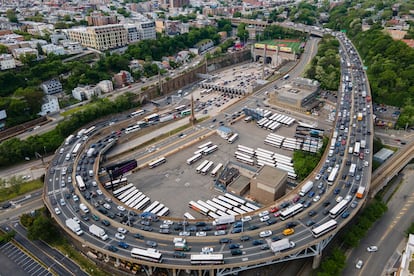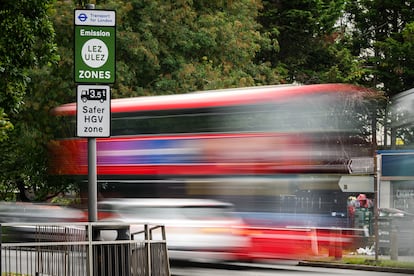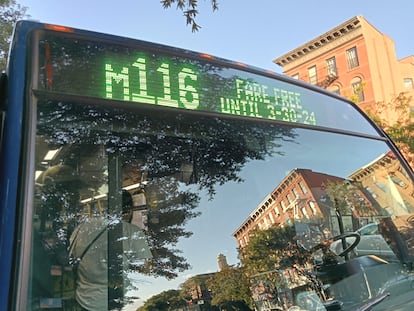New York approves the first congestion toll in the US: Drivers to be charged $15 to enter Manhattan
The measure, which is already applied in cities such as London, Milan and Stockholm, will come into effect in spring and aims to raise $1 billion a year for public transportation

For years, European cities have restricted traffic restrictions to city centers — the most densely populated areas and best connected by public transportation — in a bid to reduce traffic and improve air quality. Meanwhile, the United States has maintained an urban model, where cars are need to connect disperse residential and there are almost no traffic restrictions. But that changed on Thursday, when New York approved the first congestion toll in the country. The city will charge $15 to passenger cars that enter the central strip of Manhattan, $24 to vans and $36 to buses and large trucks. The measure, which is already applied in London, Milan and Stockholm, must be ratified in two months and is scheduled to come into effect in the spring.
The initiative, approved on Wednesday by the Metropolitan Transportation Authority (MTA), is called a “congestion pricing toll” and will be applied in a city where citizens spend an average of 236 hours a year trapped in traffic, according to a recent report. The idea is to ease traffic congestion and reduce pollution, as well as raise at least $1 billion a year to renew transportation infrastructure such as the subway.
The plan has angered the neighboring state of New Jersey, which is calling for more affordable toll prices as many of the state’s residents travel to Manhattan for work. The $15 toll ($7.50 for motorcycles) will be applied to vehicles traveling between 5 a.m. and 9 p.m. (and from 9 a.m. to 9 p.m.on weekends). In off-peak hours, the toll rate will be 75% less. There will also be discounts for low-incomes motorists (below $50,000 per year) who need the car to get around. However, as a 2022 study pointed out, most drivers who enter Manhattan have medium or high incomes, meaning only 4% of drivers will receive a discount.
Taxis will pay $1.25, which will likely fall to the passenger, like the $2.50 that will be charged to vehicles from ride-hailing platforms such as Uber and Lyft. Toll rates will also increase by 25% on the annual Gridlock Alert days, which occur during the U.N. General Assembly in September, and periods of peak travel such as Christmas. Taxis already pay a congestion toll during these days.

This model — which started in London in 2003 — consists of charging drivers to access the city center, while providing concessions to residents and vulnerable groups. The proceeds raised by the tolls are then invested into making cities more sustainable and improving public transportation. In London — where drivers are charged around $18 to enter the center — the measure has managed to reduce traffic by a third. The model has also been adopted by Milan, Stockholm, Gothenburg and Singapore.
The alternative model is to create low-emission zones, where the most polluting vehicles are banned from entering the city center. Under this system, drivers who fail to comply with the rules are fined. This model is the most commonly adopted in European cities, and is in forces in places such as Madrid and Barcelona. Olso has gone a step further and announced plans to ban all vehicles using fossil fuels from certain districts.
“Critical step forward”
The New York initiative was praised by New York Governor Kathy Hochul, who called it a “critical step forward.” But fake license plates — to circumvent the tolls — are already being sold online. A total of 122 groups have asked to be exempted from the toll, but none have been successful, not even municipal officials — including police department officers — who enter the heart of Manhattan. Ambulances, garbage trucks, firefighters and police cars will not have to pay, but their staff will have to face the cost, even if they are driving to work.
Leonard G. lives in New Jersey and works at a foreign bank in Manhattan’s financial district. Due to the time difference in the operations he carries out, his work days often begin or end at odd hours. “I’m too lazy to use public transportation at dawn, in winter, we have free parking at the bank, and it takes me 20 minutes to get there. But I will rethink going as often, as it will be very expensive,” he explains.
The proposal to charge a toll was presented by the MTA Traffic Mobility Review Board, a group of experts from the agency that oversees the subway and bus management. The proceeds from the toll will be used to maintain — and in many cases, for the complete overhaul — of the city’s aging infrastructure. Not even federal aid to renovate the tunnel that links Manhattan with New Jersey has provided a respite for MTA’s failing coffers, which have been in deficit since the pandemic.
Following approval of the proposal, a 60-day public comment and objection period begins. If no challenges such as New Jersey’s, which has filed a federal lawsuit, are successful, the agency will put the plan to a final vote and begin charging the toll in the spring. This is the first time a concrete proposal to monetize congestion has gone forward, but the idea has been around for more than half a century. The most solvent attempt was made by then-mayor Michael Bloomberg in 2008, when he proposed an $8 toll, but the New York State Assembly shot down his plans.
“A first step in the right direction”
Experts see the measure as a first step in the right direction. They believe the toll will help fund the city’s ailing subways and buses, and make the streets of Manhattan a friendlier place. It is also seen as an opportunity to put an end to the car culture in a city — perhaps the only one in the United States — that is perfectly accessible by public transportation, with the exception of isolated peripheral areas. Indeed, for this reason, some have said that the measure is not ambitious enough, arguing that it should apply to the five counties of New York.
“You have to start somewhere, and this is a great start,” says Howard Yarus, of the District 7 transportation committee. The group he represents proposed a plan in 2019 to eliminate free street parking, an unthinkable change for the urban landscape. “Until now, if I took my car, which pollutes the environment, to go downtown I didn’t pay anything, not even when parking. But if I went by public transportation, it cost me $2.90 [for a subway or bus ticket]. As a public policy, that seems terrible to me.”
Others complain that ride-hailing vehicles should be charged more given they are major contributors to traffic, along with delivery trucks. Despite the fall in traffic volume in the last decade, the average traffic speed remains slow — a fact that is especially notable on public buses, which are the slowest in the entire country. Other experts have focused on the toll’s environmental objectives. “We need to deal with climate change emissions from cars and air quality issues and road safety issues, which we’ve only seen get worse and worse in Manhattan and in the boroughs. It all comes from too many cars,” sources from the Transportation and Development Policy Institute told The New York Times on Monday.
Meanwhile, authorities are already calculating how much may be lost due to drivers with fake license plates, putting the figure at $300 million a year. In Toronto, the percentage of license plates which could not be read by traffic cameras shot up 17% after the introduction of speed radars.
Sign up for our weekly newsletter to get more English-language news coverage from EL PAÍS USA Edition
Tu suscripción se está usando en otro dispositivo
¿Quieres añadir otro usuario a tu suscripción?
Si continúas leyendo en este dispositivo, no se podrá leer en el otro.
FlechaTu suscripción se está usando en otro dispositivo y solo puedes acceder a EL PAÍS desde un dispositivo a la vez.
Si quieres compartir tu cuenta, cambia tu suscripción a la modalidad Premium, así podrás añadir otro usuario. Cada uno accederá con su propia cuenta de email, lo que os permitirá personalizar vuestra experiencia en EL PAÍS.
¿Tienes una suscripción de empresa? Accede aquí para contratar más cuentas.
En el caso de no saber quién está usando tu cuenta, te recomendamos cambiar tu contraseña aquí.
Si decides continuar compartiendo tu cuenta, este mensaje se mostrará en tu dispositivo y en el de la otra persona que está usando tu cuenta de forma indefinida, afectando a tu experiencia de lectura. Puedes consultar aquí los términos y condiciones de la suscripción digital.
More information
Últimas noticias
There is as much life left to discover on planet Earth as that which is already known
Dozens presumed dead, around 100 injured in fire at Swiss Alps bar during New Year’s celebration
Is porn for women different from conventional porn? We spoke to those who make it
Cartagena de Indias is sinking: What can the city do to mitigate it?
Most viewed
- Sinaloa Cartel war is taking its toll on Los Chapitos
- Reinhard Genzel, Nobel laureate in physics: ‘One-minute videos will never give you the truth’
- Oona Chaplin: ‘I told James Cameron that I was living in a treehouse and starting a permaculture project with a friend’
- David King, chemist: ‘There are scientists studying how to cool the planet; nobody should stop these experiments from happening’
- Why the price of coffee has skyrocketed: from Brazilian plantations to specialty coffee houses










































